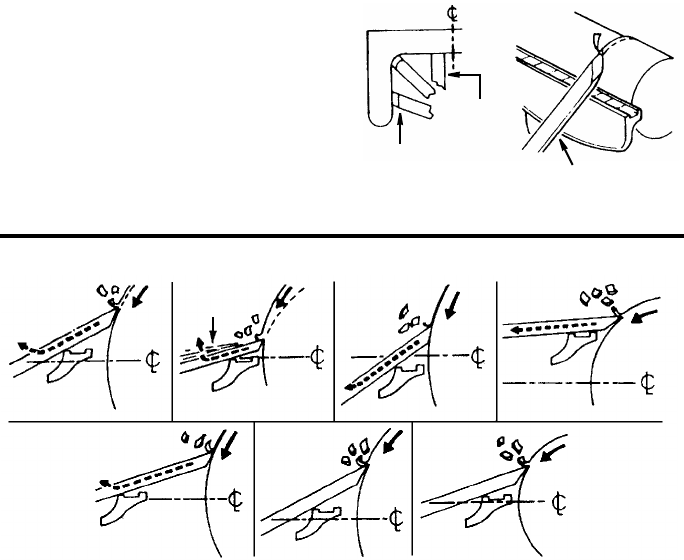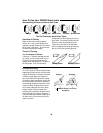
31
When You Can Cut, and When You
Must Scrape
There are two different approaches to the
work when turning. One approach is
toward a circumference of the workpiece
(for example, turning down the outer sur-
face of a cylinder or the inner wall of a hol-
low round box). In this approach, the
surface being turned travels under the
chisel edge like an endless belt. The sec-
ond approach is toward the diameter of a
workpiece (as when turning the face of a
faceplate turning, or the side of a large
shoulder on a spindle turning). In this
approach the surface being turned rotates
like a disc under the chisel edge. Some-
times the approach will be a combination
of both.
Either a cutting or scraping action can be
used when the approach is toward a cir-
cumference - the shaving is removed like
a peeling from a potato. Scraping, only,
can be used when the approach is toward
a diameter. The reason is obvious when
you consider that faceplate turning practi-
cally always requires removal of wood
across the grain. Wood does not peel
easily across the grain, and attempts to
use cutting methods will likely result in
damage to the work and throwing of the
chisel by the work.
It follows that a cutting action is used for
the general run of spindle turning opera-
tions...while the major part of a faceplate
turning is done by the scraping method.
When a combination approach is to be
used, you will have to judge, by the feel of
the work, when to stop cutting and start
scraping. Never try to cut when it
becomes difficult to hold the chisel
against the roughness of the wood grain.
How to Position Tool Rest for Circum-
ference Cutting
When cutting, the object is to pierce the
outer skin of wood to a certain desired
depth, then to hold the chisel steady, with
the bevel edge parallel to the work cir-
cumference, so that it will peel off a shav-
ing at this desired depth. The only sure
method of holding the chisel steady is to
rest the bevel against the work, as shown
in sketch 1. When the tool rest is at the
proper height (sketch 1), the chisel can be
held with the bevel pressed against the
work, and the tool rest will act as a ful-
crum to support the chisel against the
downward force of the revolving work.
Diameter
Approach
Circumference
Approach
Circumference
Approach
Steady
Thrust
Against
Hands
12 3 4
5
6
7
Force
against
work
.
Chisel
cutting
properly
.
Chatter
No support
for
bevel
point
digging
in.
Bevel
Kickback
Kickback
Handle
Kicked Up
Small
Diameter
Rest too low;
chisel too horizontal.
Rest
too low.
Chisel
too high.
Rest too
high
-
chise
l
too high
on work
.
Rest too distant-chisel too
high, point too far from rest.
Large
Diameter


















